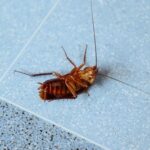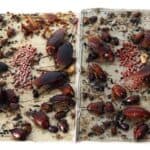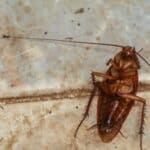There are many different insecticides for rid of cockroaches in the home. To select the right type of insecticide, you need to know how each one works.
Insecticides work on cockroaches by damaging their nervous system or affecting their ability to process food. Nervous system damage prevents roaches from moving, resulting in starvation. Organ damage will stop the cockroach from digesting food or water, and it will die from dehydration or a lack of nutrients.
Cockroaches are so resilient and adaptable. Many bait traps rely on the poisoned cockroach taking that insecticide back to its colony. The other cockroaches will be immobilized or struggle to process nutrients and starve to death.
How Insecticide Kills Cockroaches
Insecticides kill cockroaches by turning their biology against them. Because they are so adaptable, durable, and resilient, the only thing that can kill them is their own metabolism. If a roach is unable to eat, it cannot fuel its nigh-indestructible body. Its body will then waste away from lack of food, and its organs will fail. Only then will it die.
All insecticides rely on causing the roach to starve or dehydrate. However, each one goes about achieving this goal differently. This is designed to get different results based on the needs of the homeowner or exterminator using the poison. What you pick depends on:
- How easily you can get the poison onto the roach
- The size of the cockroach population
- How much poison (and what kind of poison) you expose your household to
- How quickly you need results
Nervous System Damage
Some insecticides will attack a roach’s nervous system. Specifically, it blocks electrical stimuli from the brain to the rest of the body. This makes the roach lose control of its motor skills and become unable to fend for itself.
Once the nervous system is compromised, a roach will twitch and flip onto its back, its legs curling in on itself. These poisons are the so-called fast-action or instant-kill variety so commonly found on brand labels. They are usually applied directly to cockroaches, requiring you to spray or douse them in the formula.

Organ Damage
Other insecticides will act as a slow poison, damaging their internal organs until they can no longer function. This will inhibit a roach’s ability to eat or process the food that it does consume. As such, it will experience a nutrient deficiency and die from starvation.
These poisons may also damage the outer layer of a roach’s body. This layer is responsible for the roach being able to stay hydrated. With that layer destroyed, the roach will perish from dehydration.
These options take longer to work. They also require a small amount of planning and thought as to where they will be used. However, under the right conditions, they can be devastating, especially to large colonies.
How Different Insecticides Work
Apart from those categories, insecticides get broken down into two more categories. That’s because insecticides come in two physical forms:
Insecticide Spray
These come in handy cans that you can spray on any roach you physically see. Sprayed insecticide consists of either:
- Liquid options that douse surfaces
- Compressed aerosols that produce airborne particles
These aim to saturate the roaches themselves. The poison – pyrethrum or pyrethroids are the active ingredients in most sprays – gets into the trachea and wreaks havoc on their nervous systems. It paralyzes and eventually kills them through starvation.
Their effects are noticeable in seconds. That’s why they are frequently labeled as instant by manufacturers. However, sprayed insecticide carries the risk of inhalation. Any area where it’s used should be vacated for a brief time until the particles have dispersed.
Sprayed insecticide will not get rid of infestations. That’s because each roach needs to come into direct contact with the ingredients. However, the active components can be long-lasting and will act as irritants. This forces them to relocate out of their hiding places and perhaps come into contact with other traps set for them.
Insecticide Powder
This is used in bait traps. It can also be sprinkled in areas you know roaches will traverse when you’re not around. Powdered insecticide dust is applied in strategic locations. The powder needs to be consumed to be effective, so it’s mixed with other substances.
Once eaten, powder insecticides will affect the roaches’ digestive system. It can even be passed from roach to roach. The powder will also affect a roach’s ability to stay hydrated or correctly process water. This expedites their death because of dehydration, which kills roaches faster than starvation alone.
These insecticides are considered a safer option. Their toxicity and volatility are lower than sprays, so it’s less likely to harm you. It’s wise to use a powdered insecticide in areas that are unreachable by children or pets. The best place will be cracks and crevices where you suspect (or know) that insects crawl through. This includes:
- Kitchen cabinets
- The back of your closet
- Under your car seat
A powdered insecticide is effective at reaching otherwise inaccessible areas, such as the nest. By walking through the dusty powder, they coat themselves in it and carry it back to their colony. This might even be deep inside your walls.
How Does Pyrethrin Kill Cockroaches?
Obviously, the instant-kill nature of spray poison sounds appealing. How does it actually work? What could affect a roach’s nervous system so immediately? That’s due to the presence of pyrethrum.
This natural insecticide is taken from the flower of the chrysanthemum. It’s made into a powder by grinding the flower or turning it into a water or oil solution. Pyrethrum is composed of different pyrethroids. These affect the nervous system by inhibiting electrical impulses from the brain onto its extremities, rendering a cockroach immobile.
Once immobile, the roach will flip onto its back. This is due to the way most insects are built. They have a hard shell or exoskeleton covering their thorax and/or backs. This is matched to long, thin legs supporting it from underneath. This means that they’re top-heavy. They continuously use their legs to stay upright, and roaches are no exception.
According to the Department of Community Medicine and Institute of Health & Medical Sciences, once the chemicals start affecting a cockroach’s nervous system, it can no longer keep its balance. Due to a high center of gravity, it will topple over. It lays there until it starves or is killed by other predators or humans.
Synthetic Pyrethroid
Pyrethrum, being a natural compound, is a non-persistent insecticide. In other words, it naturally degrades after being exposed to UV light and pH changes. As such, scientists have created synthetic pyrethroid. This man-made version of the chemical:
- Lasts longer
- Resists the effects of UV light
According to Wiley-VCH, this makes it ideal to use in agriculture. The most common synthetic pyrethroids are:
- Cypermethrin: A light-resistant but relatively more toxic strain
- Permethrin: A slightly less toxic version, chlorinated to resist UV degradation
For cockroaches, both versions are similarly effective, causing the paralyzing effect that leads to eventual death.
Despite their effectiveness, their toxicity is low enough to avoid putting people and some pets at risk if used correctly. According to the National Institute of Malaria Research, pyrethroids and pyrethrins are found in more than 3,500 commercial products. Because of their natural origins, they’re considered safe, despite being chemical replicas.
Cypermethrin Vs. Permethrin For Roaches
So, out of the two forms of synthetic pyrethroid, which is better? How do they work?
Cypermethrin
Cypermethrin is among the most common insecticides. It functions as a fast-acting neurotoxin on the insect’s nervous system, causing paralysis and death. It is found in:
- Insecticide sprays, such as Raid and Ortho
- Products, such as ant chalk
Keep in mind that ant chalk, or Chinese chalk, is illegal inside the United States. This is largely due to its packaging not properly conveying the health risks associated with these chemicals. Nevertheless, there is a rampant black market for these chalks, being sold at corner stores across the country, as they are very effective.
However, cypermethrin is toxic to cats, fish, and bees, which should be considered. Classified as a broad-spectrum insecticide, it can harm beneficial insects as well as pests. It’s also used in agriculture as a pesticide to eliminate endoparasites.
Cypermethrin is one of the most potent chemical weapons at our disposal against cockroaches. That makes it a good choice when you need heavy-handed results, but caution should always be exercised. It is harmful to humans, irritating the eyes and skin. After prolonged exposure, effects can include:
- Numbness
- Loss of coordination
- Dizziness
- Seizures
- Possible death
Permethrin
Permethrin, while toxic to insects, can be handled by humans. In fact, it’s even used as medication. It is commonly used to treat lice and scabies. As the main ingredient in most bug repellents, it can safely be applied directly to the skin.
On animals, it is an entirely different outcome. It does not discriminate between pests and pollinators. Bees are annihilated by it as well as cockroaches, mosquitoes, and other pests. Cats are also at risk.
Nuvan Insecticide For Cockroaches
Nuvan is an aerosol-based insecticide that contains the active ingredient dichlorvos. This is an organophosphate used to control household pests. It can be safely used on:
- Mattresses (with linen removed)
- Tables
- Shelves
- Furniture
People and pets must vacate the area until it has dried. This takes about 2 hours, and then it’s safe to re-enter.
Dichlorvos has the same functionality as pyrethrin and pyrethroids. It attacks an insect’s nervous system. As a bonus, it is also particularly aggressive against bed bugs.
This chemical has been banned in the EU since 1998. It has a high level of toxicity, which can be harmful to people and pets. According to the American Academy of Pediatrics, it has also been linked to the increased incidence of ADHD in children. So, if you find this ingredient listed on the insecticide you get, proceed with caution.

Best Chemical For Cockroaches
The best chemical for killing roaches may be more natural. In recent years, cockroaches have become immune to multiple insecticides, especially synthetic varieties.
Roaches developing insecticide resistance is no new thing. It’s part of the reason why fumigators and farmers work with an insecticide concoction on crops, buildings, and residential areas. If one insecticide proves ineffective, then another should get the job done.
For everyday household use, the best chemical may be boric acid. It’s a white, odorless, non-flammable, natural insecticide. It’s created by mixing water and boron, which is a naturally occurring compound.
Boric acid is considered the best insecticide for cockroaches. It’s relatively harmless to humans and household pets – at least in the small doses necessary to kill off cockroaches. This earns itself the title of safest insecticide. It also has the added convenience of having a cascading effect on an infestation.
How Does Boric Acid Kill Cockroaches?
The whitish dust clings onto the bodies of the roaches, sinking into the oily membrane that covers their body. This membrane functions to keep the roach hydrated. It is, incidentally, this same oily substance that gives roaches their distinctive and foul-smelling odor. Once the roach’s body absorbs boric acid, it destroys this protective oil. That dehydrates the cockroach, eventually desiccating and killing it.
Boric acid can also be mixed with flour and sugar. It’s then placed in small portions around areas where roaches are known to frequent. Cockroaches, being adept at seeking out food, will come across this enticing meal. Exactly what occurs when cockroaches ingest this bait is still under contention. However, there is evidence of the substance destroying the inner lining of the foregut, or esophagus, leading to starvation.
Boric acid is a slow-acting poison, taking up to several days to bring a roach to its demise. This is advantageous to the homeowner, though. It gives the roach time to return to its colony. Once there, it will come into contact with the rest of the infestation, covering the others in the boric acid still clinging to it.
The mass elimination begins with the death of a roach. Once a cockroach dies, the scent of its carcass will draw others in who will eat it. In doing so, they ingest the same poisonous substance that killed the first roach, repeating the cycle. This will initiate a cascade that leads to population collapse and the eventual downfall of the entire colony.
Biological Control Of Cockroaches
As part of the animal kingdom, cockroaches not only have to deal with insecticides. Natural predators can also eliminate them. If you want to avoid chemicals, you can try introducing creatures that directly attack cockroaches and keep their population in check. Common natural predators that feed on roaches include:
- Reptiles, such as lizards, geckos, and other reptiles that can freely roam in or around your home
- Amphibians, such as frogs or turtles
- Birds in general
- Other insects, including certain species of beetles
On their own, these creatures will not reduce the roach population to zero. However, they can control it to a certain degree. You will still need to use insecticides on a colony.
The most effective way to deal with roaches is starvation. Remove their access to food and use chemicals that prevent them from eating. By doing so, their population will diminish and eventually die off.




